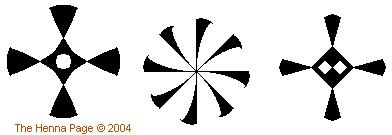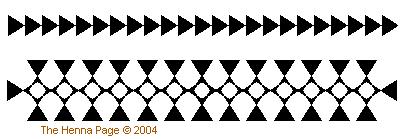|
Henna for
Children in
Siwa Oasis, Egypt
Catherine Cartwright-Jones © 2004 Kent State University Siwa Oasis is an area of over one thousand springs in northwestern Egypt, near the Libyan border. The 1966 census listed over 130,000 living in the area, scattered in villages around the water sources. The people of Siwa are genetically related to Algerian Amazigh, and their customs are distinct from people who live in the Nile delta and eastern deserts. The Siwan language is a dialect of Amazigh; many Siwans are bilingual with Arabic and Siwan. Ahmed Fakhry lived in and studied Siwan village life in the mid twentieth century, recording the life, customs, and history, and in his book, Siwa Oasis, he mentions some of the henna use. When a new child was born in a Siwan village in the during and up to the mid-twentieth century, the mother rested quietly with her infant for the first week or more, in the privacy of her home. Close relatives might visit her, but she was generally secluded, attended only by her midwife. On the seventh day after birth, the mother’s friends and their children came to visit and had a meal to honor a local saint, Sidi Sulayman and then the child was named. If the baby was a son, the father named him. If the baby was a daughter, the mother named her. Once the child’s name was pronounced, people took their first look at the baby. The midwife dabbed a bit of henna on the child’s cheeks, nose, and legs, to protect the child from the Evil Eye, which might attack the child though a guest’s admiring gaze. When they had all seen the child, the guests and their children went out into the street. The women ululated and trilled, shouting the name of child and the father, announcing new life in the town.  Solar Patterns from Siwa Solar Patterns from Siwa When the children had all run off down the streets to play, women brought a large new clay bowl to the mother’s room. They filled it halfway with water, gathered in a circle around it, and put their silver jewelry into it. The silver jewelry in water was to attract the Evil Eye, lurking about the mother’s room since she went into labor. The Evil Eye was attracted to the blood of childbirth, the health and fertility of the mother, the joy of the family, as well as the beauty of the new child. The dazzling and enticing silver jewelry in the water drew the Evil Eye away from the mother and child and held its attention with the silver jewels in the bowl. The midwife recited blessings so that the child would thrive and be happy. The women raised and lowered the bowl seven times and then smashed it to the floor, scattering water, pieces of the now-broken bowl, and jewelry everywhere! The Evil Eye was thus expelled, and the child and mother were safe.  Solar patterns from Siwa adapted for henna Siwan families also hennaed their sons at circumcision. These boys were not circumcised in clinics at birth but in a public family celebration when they were four or more years old. The family had to save up considerable money to have a suitable circumcision party-- to purchase a sheep to sacrifice for the feast, and fine clothing for the son. The parents invited, gave gifts to, and fed all their relatives for a circumcision. If they were a wealthy and important family, they invited the whole village. The day before the circumcision, the boy’s head was shaved. The family women gathered to celebrate this ceremonial haircut. The barber left little tufts of hair, and the women gave him coins to cut the last bits cleanly off, cheering, ululating, and trilling for each last snip. They hennaed the child’s hands as if he were a bride.  Solar patterns from Siwa adapted for henna The next morning, the day of the circumcision, the boy’s family took him to the Tamusi spring, the same spring where brides were taken for their nuptial cleansing. The child was bathed and celebrated just as if he were a bride, and then he was taken back home for the circumcision. The boy, with hennaed hands and kohled eyes, in the best garments his parents could buy or borrow, was often placed on a decorated bed like a bride in her nuptial bed. The boy was urged to be “grown up” and brave and not cry out during the circumcision, and certainly to hold still. A barber did the circumcision, or some other experienced person with a sharp blade, and the child’s uncles did their best to keep him from moving. Women ululated the circumcision cut, and the skin was celebrated. The circumcision wound was smeared with henna and tied with clean cloth. The family offered a feast of meat from the sacrificed sheep to the people in attendance. The sun has been a symbol of fertility, beauty, and protection in Siwa Oasis since the New Kingdom period of Egypt, when the temple of Amun was located in Siwa. Amulets and protective patterns are images of the sun, and these patterns are adapted from images of the eye of the sun, often as a solar cross or sun wheel.  Patterns from Siwa adapted for henna Warnings about henna, infants and children It is important to know that the traditions of hennaing an infant are not without serious risk! A very sour mix of henna, such as vinegar or lemon juice and henna, applied and wrapped, can irritate an infant’s skin! Babies have much thinner and more permeable skin than older children and adults. Also, a henna application will penetrate an infant’s skin and destroy blood cells. Large henna applications, such as full palm, sole and scalp, can destroy enough blood cells to cause hyperbilirubinemia in a newborn. In the case of an infant with G6PD deficiency, henna applications can break down, or hemolize, enough blood cells to seriously injure the child, and even cause death. Anyone who wishes to apply henna to an infant should do so only in the smallest possible dabs, and without addition of a sour liquid to the paste. G6PD deficient children, aged four and older, are still at risk for serious injury if they are hennaed extensively as may be done to celebrate a circumcision. If an artist is asked to henna a child and does not know whether or not the child is G6PD deficient, it is best to apply only very small patterns so as to not cause potential injury. For more information on Siwa, please read: http://news.bbc.co.uk/1/hi/world/middle_east/3758950.stm
http://www.haberlah.com/hosted/siwa/ http://piazza.iae.nl/users/lewis/siwah.htm For more information on infants and henna, please read http://www.hennapage.com/henna/encyclopedia/medical/neonatal.html
http://www.hennapage.com/henna/encyclopedia/medical/g6pd.html For more information on Amazigh henna traditions of mothers and newborns, read Web Resources on Hyperbilirubinemia: Web resources on Glucose - 6 - Phosphate Dehydrogenase Deficiency: http://health.allrefer.com/health/
http://www.emedicine.com/med/topic900.htm http://www.healthatoz.com/healthatoz/Atoz/ency/ References: Cartwright-Jones, Catherine “Henna's Significance in Amazigh Id, Circumcision and Night of the Henna Celebrations” Henna Page Publications c 2003 Fakhry, Amhed “Siwa Oasis” The American University in Cairo Press 1973 Kandil HH, Al Ghanem MM, Sarwat MA, Al-Thallab FS “Henna (Lawsonia inermis Linn.) inducing haemolysis among G6PD-deficient newborns. A new clinical observation.” Annals of Tropical Paediatrics 1996; 16; 287-91 P Raupp, J Ali Hassan, M VArughese, B Kristiansson “Henna causes life threatening haemolysis in glucose-6-phosphate dehydrogenase deficiency” Department of Paediatrics, Tawam Hospital, Al Ain, United Arab Emirites Buraimi Hospital, Al Buraimi, Oman Oasis Hospital, Al Ain, United Arab Emirites Archives of Disease in Childhood Volume 85 Issue 5 2001 Pages 411-412 Zinkham, and Oski "Henna: A Potential Cause of Oxidative Hemolysis and Neonatal Hyperbilirubinemia" Pediatrics Vol. 97, No 5, May 1996 Zinkham and Oski “Henna: a potential cause of oxidative hemolysis and neonatal hyperbilirubinemia “ Pediatrics 1996; (suppl 394) 58 - 76 Back to the Encyclopedia of Henna Index Can't
find
what you're looking for?
Try:
The Henna Page Main Index http://www.hennapage.com/henna/mainindex.html *"Henna,
the
Joyous Body Art"
the Encyclopedia of Henna Catherine Cartwright-Jones c 2000 registered with the US Library of Congress TXu 952-968 |